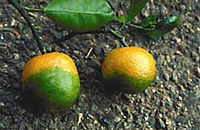
Photo from wikipedia
Huanglongbing (HLB) is a severe disease of citrus caused by the bacterium Candidatus Liberibacter. In America, the most common species is Candidatus Liberibacter asiaticus (CLas). In a previous study of… Click to show full abstract
Huanglongbing (HLB) is a severe disease of citrus caused by the bacterium Candidatus Liberibacter. In America, the most common species is Candidatus Liberibacter asiaticus (CLas). In a previous study of the Citrus-HLB pathosystem, our group found differences in CLas multiplication in a population of hybrids obtained by hybridization between Citrus sunki Hort. Ex Tan. and Poncirus trifoliata (L.) Raf. cv. Rubidoux. The bacterial concentration was higher in C. sunki than in P. trifoliata. Thus, this study aims to map phenotypic (QTL) and gene expression (eQTL) data associated with host response to CLas in the linkage groups (LGs) of the previously constructed parental maps of C. sunki and P. trifoliata cv. Rubidoux. For the phenotypic analysis, we used a population of 79 F1 hybrids (termed citrandarins) between C. sunki and P. trifoliata. CLas and starch were quantified in the leaves of the plants two years after pathogen inoculation, allowing the classification of hybrids as resistant, tolerant, and susceptible. The expression of 14 candidate genes was measured in 72 hybrids of the population and used as expression data for the eQTL mapping. We located nine QTL and 52 eQTL in the C. sunki map and 17 QTL and 40 eQTL in the P. trifoliata map. The overlap of eQTL of the majority of genes with QTL from the phenotypic data indicates that the genes are related to the phenotype and are probably related to pathogen infection.
Journal Title: Tropical Plant Pathology
Year Published: 2020
Link to full text (if available)
Share on Social Media: Sign Up to like & get
recommendations!